
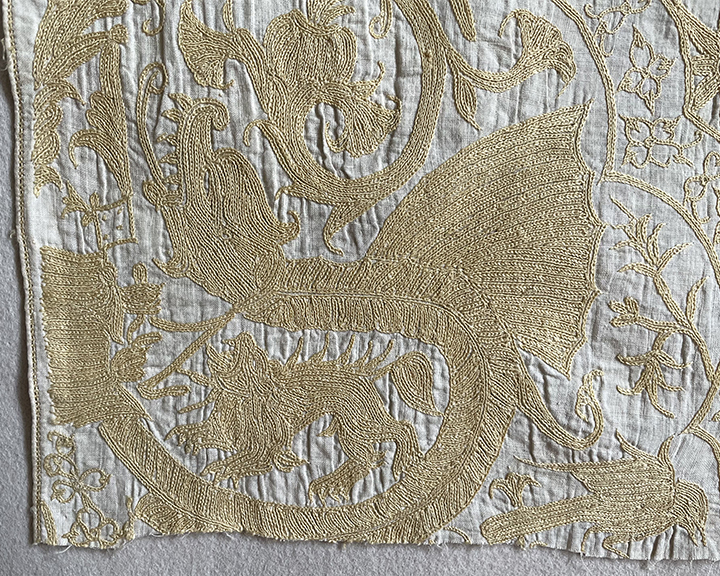
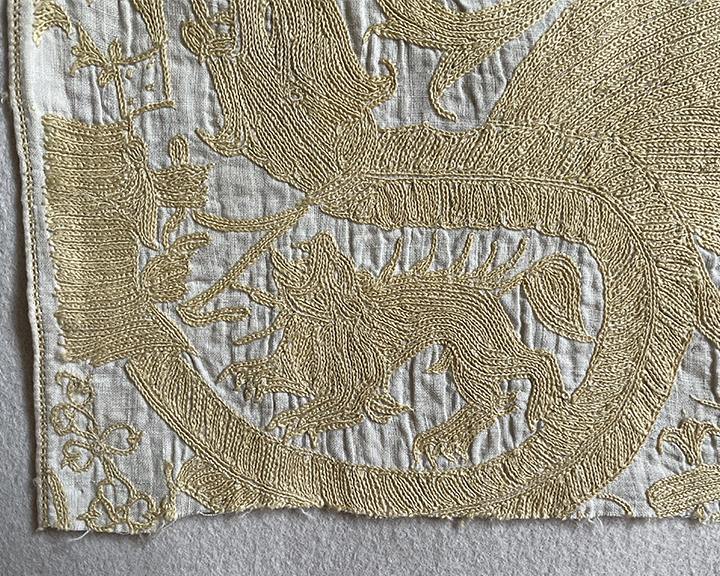
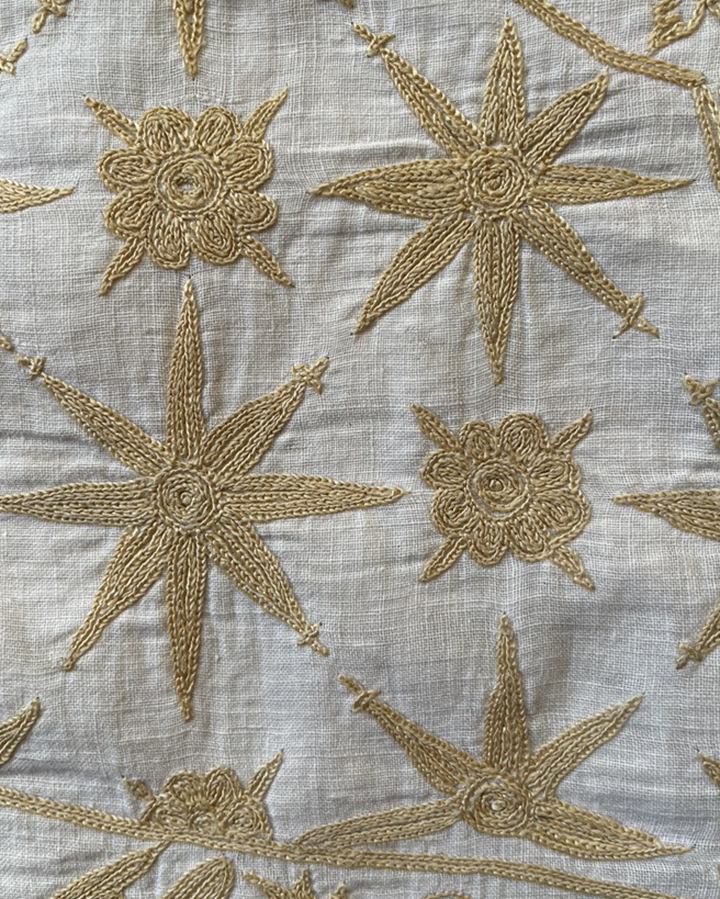
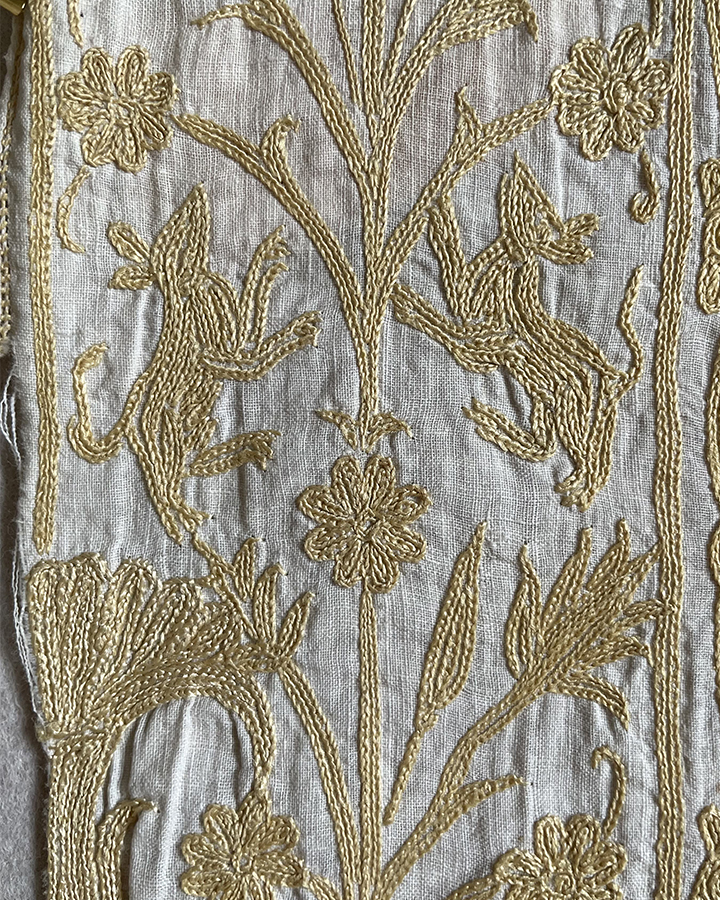
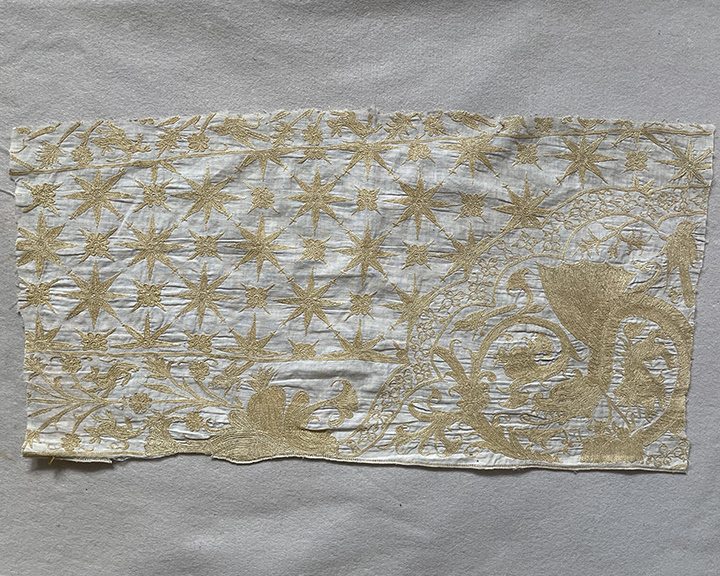
A very rare section (D) from a colcha or coverlet embroidered in Satgaon, the mercantile capital of Bengal, near Calcutta (Kolkata). Colchas were commissioned by the Portuguese for the lucrative export market from the mid-16th to the mid-17th century. The Portuguese arrived in India in1498 with the Portuguese settlement of Satgaon established in 1538. Bengal was recognised for its beautiful textiles and the merchants realised the commercial opportunity of selling colchas to their aristocratic domestic market as well as to elsewhere in Europe. Colchas were also popular in England, where they appeared at auctions in the early seventeenth century.* Many of the colchas or bedcovers were quilted and depicted Portuguese hunting scenes.
Embroidered on local cotton in tambour stitch in natural yellow Tussah silk, which grows wild in Eastern India. Sometimes these are brightish yellow or rich cream and more neutral shades. For Western export market goods the designs would be supplied by the Portuguese traders, often resulting in both Eastern and Western motifs. Hunting, biblical, marine or mythological scenes were frequently portrayed with people dressed in Portuguese clothing, together with scrollwork. One wonders who in Portugal actually designed these. A design would have been drawn on paper and then pricked and pounced on to cloth. The embroidery lines then drawn in with ink. They were then sent out to Satigaon where the Bengali man embroidering the piece would have interrupted the design, hence the charmingly naive people, animals depicted. Coverlets and hangings, but also clothing was made in the same manner, sometimes quilted. Marika Sardar writes in Interwoven Globe that a visiting Dutchman Jan Huyghen van Linschoten, who was in India from 1583-1589, wrote that pillows, shaving cloths, children's baptismal cloaks, hair mantles (to protect clothes when combing hair) and capes fashionable amongst Portuguese men at this time were all being produced**
This piece must have been part of one of the quarter medallions at a corner of a coverlet, the lower edge being a finished edge.
I have several more pieces from the coverlet, mainly borders with pairs of birds and the central panel with stars. Please ask for photos.
I have included this piece in the English & European Textiles as well as in World Textiles, because these embroideries were made for the Western market.
The fierce and writhing mythical winged dragon, whose tail encloses a lion or dog, and two birds all within a cusped medallion, the lower left border with two sprightly tailed, long legged creatures and a bird besides a densely embroidered sea fruit and leaves, the centre with spiky star repeats, all in natural yellow tussah silks on a natural cotton ground.
10 1/2 x 20in; 27 x 50 cm
Excellent apart from a section of the lower edge 2 3/4 in; 7 cm missing. Clean and fresh.
* The Embroideries at Hardwick Hall. Santina M Levey p 389.
Interwoven Globe. The Worldwide Textile Trade 1500-1800. A Peck (ed). Metropolitan Museum of Art, New York, 2013. p 147. www.metmuseum.org/art/collection/search/22946
Arts of Bengal Veronica Murphy. Whitechapel Art Gallery/V & A exhibition.
Indo-Portuguese Embroideries of Bengal Art. J Irwin. Journal of the Royal India, Pakistan and Ceylon Society. Vol. XXVI, No. 2, 1952, pp. 65-73.
Indian Embroideries John Irwin & Margaret Hall 1973, pls 43-45.
Portugal and the East through Embroidery. 16th to 18th century coverlets from the Museu Nacional de Arte Antiga, Lisbon. p 18
Embroidered quilts from the Museu Nacional de Arte Antiga Lisboa, M J de Mendonca. exh. cat. Kensington Palace, London, 1978, no. 6;
The Narrative Scheme of a Bengal Colcha Dating from the Early 17th Century Commissioned by the Portuguese, B. Karl, Textile Society of America Symposium Proceedings, Lincoln, Nebraska, 2006, pp. 438-448;
Arts of India 1550-1900. John Guy & Deborah Swallow p 46-50. The V & A has a coverlet with the arms of a Portuguese family.
The earliest survivors? The Indian embroideries at Hardwick Hall, in R. Crill, (ed.), Textiles from India: the Global Trade. Calcutta, 2006, pp.245-260.
Indian embroideries for the Portuguese market, end of 16th century/beginning of 17th century, The Textile Collection of the Museu Nacional de Arte Antiga, T. P. Pereira and C. Serrano, Lisbon, 2007.
A. Peck (ed.) Interwoven Globe, The Worldwide Textile Trade, 1500-1800, Metropolitan Museum of Art, New York, 2013. p 147. www.metmuseum.org/art/collection/search/22946
KARL, Barbara (2016), Embroidered Histories: Indian Textiles for the Portuguese Market during the Sixteenth and Seventeenth Centuries. Vienna and Köln: Böhlau Verlag.
All images and text © meg-andrews.com 2021